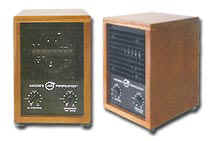Moisture Control
Water in your home can come from many
sources. Water can enter your home by leaking or by seeping through
basement floors. Showers or even cooking can add moisture to the air
in your home. The amount of moisture that the air in your home can
hold depends on the temperature of the air. As the temperature goes
down, the air is able to hold less moisture. This is why, in cold
weather, moisture condenses on cold surfaces (for example, drops of
water form on the inside of a window). This moisture can encourage
biological pollutants to grow. It is the main source of household mold
and mildew in the home.
Household Mold
 |
After
you get the moisture under control, try LightningAir
Products All of these take care of household mold
spores in the air. |
View Our
Entire Products List
There are many ways to control moisture
in your home and reduce household mold and mildew:
- Fix leaks and seepage. If water is
entering the home from the outside, your options range from
simple landscaping to extensive excavation and waterproofing. (The
ground should slope away from the home.) Water in the basement
can result from the lack of gutters or a water flow toward the
house. Water leaks in pipes or around tubs and sinks can provide a
place for household mold to grow.
- Put a plastic cover over dirt in
crawlspaces to prevent moisture from coming in from the ground. Be
sure crawlspaces are well-ventilated.
- Use exhaust fans in bathrooms and
kitchens to remove moisture to the outside (not into the attic).
Vent your clothes dryer to the outside.
- Turn off certain appliances (such as
humidifiers or kerosene heaters) if you notice moisture on windows
and other surfaces.
- Use dehumidifiers and air
conditioners, especially in hot, humid climates, to reduce
moisture in the air, but be sure that the appliances themselves
don't become sources of biological pollutants.
- Raise the temperature of cold
surfaces where moisture condenses. Use insulation or storm
windows. (A storm window installed on the inside works better than
one installed on the outside.) Open doors between rooms
(especially doors to closets which may be colder than the rooms)
to increase circulation. Circulation carries heat to the cold
surfaces. Increase air circulation by using fans and by moving
furniture from wall corners to promote air and heat circulation.
Be sure that your home has a source of fresh air and can expel
excessive moisture from the home.
- Pay special attention to carpet on
concrete floors. Carpet can absorb moisture and serve as a place
for biological pollutants to grow. Use area rugs which can be
taken up and washed often. In certain climates, if carpet is to be
installed over a concrete floor, it may be necessary to use a
vapor barrier (plastic sheeting) over the concrete and cover that
with sub-flooring (insulation covered with plywood) to prevent a
moisture problem.
- Moisture problems and their
solutions differ from one climate to another. The Northeast is
cold and wet; the Southwest is hot and dry; the South is hot and
wet; and the Western Mountain states are cold and dry. All of
these regions can have moisture problems. For example, evaporative
coolers used in the Southwest can encourage the growth of
biological pollutants. In other hot regions, the use of air
conditioners which cool the air too quickly may prevent the air
conditioners from running long enough to remove excess moisture
from the air. The types of construction and weatherization for the
different climates can lead to different problems (such as
household mold) and solutions.
Moisture On Windows
Your humidistat is set too high if
excessive moisture collects on windows and other cold surfaces. Excess
humidity for a prolonged time can damage walls especially when outdoor
air temperatures are very low. Excess moisture condenses on window
glass because the glass is cold. Other sources of excess moisture
besides overuse of a humidifier may be long showers, running water for
other uses, boiling or steaming in cooking, plants, and drying clothes
indoors. A tight, energy efficient house holds more moisture inside;
you may need to run a kitchen or bath ventilating fan sometimes, or
open a window briefly. Storm windows and caulking around windows keep
the interior glass warmer and reduce condensation of moisture there.
Humidifiers are not recommended for use
in buildings without proper vapor barriers because of potential damage
from moisture buildup. Consult a building contractor to determine the
adequacy of the vapor barrier in your home. Use a humidity indicator
to measure the relative humidity in your home. The American Society
of Heating and Air Conditioning Engineers (ASHRAE) recommends these
maximum indoor humidity levels.
How do
ozone generators work? Learn how
View Products
|

